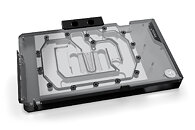
ASUS ROG Astral RTX 5090 BTF Edition Debuts with GC-HPWR Connector
ASUS has expanded its BTF GPU ecosystem with the launch of the ROG Astral GeForce RTX 5090 32 GB GDDR7 BTF OC Edition, marking the first Astral model to adopt the detachable Graphics Card High-Power (GC-HPWR) connector. Building on improvements showcased in version 2.5, this new variant is engineered to supply over 1,000 watts through the high-power slot alongside the traditional 12V-2x6 connection located behind the PCIe connector. The ROG Astral RTX 5090 BTF Edition inherits the core specifications of its non-BTF sibling, which we reviewed here, but distinguishes itself with enhanced power delivery and compatibility. ASUS's removable GC-HPWR adapter allows integration with both standard motherboards and upcoming BTF-ready boards, promising greater flexibility for system builders and the aesthetic experience of no cables connected to the GPU.
This model employs the same four-fan configuration, vapor chamber, and optimized fin spacing, while a phase-change GPU thermal pad ensures maximum contact with the GPU die. According to ASUS, the quad-fan layout can boost airflow and pressure by up to 20%. Additional features include real-time monitoring of temperatures and power draw on the 12V-2x6 connector, accessible via GPU Tweak III, which also provides fine-tuning controls such as voltage and frequency adjustments, as well as thermal mapping. Although pricing has yet to be confirmed, ASUS will reflect the card's feature set with a price increase. Availability is expected in the third quarter, alongside other BTF products, such as the white-edged TUF Gaming Radeon RX 9070 XT and various ROG motherboards.
This model employs the same four-fan configuration, vapor chamber, and optimized fin spacing, while a phase-change GPU thermal pad ensures maximum contact with the GPU die. According to ASUS, the quad-fan layout can boost airflow and pressure by up to 20%. Additional features include real-time monitoring of temperatures and power draw on the 12V-2x6 connector, accessible via GPU Tweak III, which also provides fine-tuning controls such as voltage and frequency adjustments, as well as thermal mapping. Although pricing has yet to be confirmed, ASUS will reflect the card's feature set with a price increase. Availability is expected in the third quarter, alongside other BTF products, such as the white-edged TUF Gaming Radeon RX 9070 XT and various ROG motherboards.


























































































